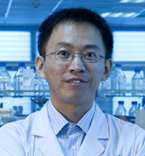Yicheng SUN
Ph.D., Associate professor
Tel: 86-10-67837366
Email: sunyc@ipbcams.ac.cn
Research interests:
Discovering the genetic basis of biofilm formation.
Discerning the role of biofilms in host-pathogen interactions and resistance to antibiotic therapy.
|
 |
 |
Selected publications:
- Guo XP, Ren GX, Zhu H, Mao XJ, Sun YC: Differential regulation of the hmsCDE operon in Yersinia pestis and Yersinia pseudotuberculosis by the Rcs phosphorelay system. Sci Rep 2015, 5:8412.
- Sun YC, Jarrett CO, Bosio CF, Hinnebusch BJ: Retracing the evolutionary path that led to flea-borne transmission of Yersinia pestis. Cell Host Microbe 2014, 15(5):578-586.
- Ren GX, Yan HQ, Zhu H, Guo XP, Sun YC: HmsC, a periplasmic protein, controls biofilm formation via repression of HmsD, a diguanylate cyclase in Yersinia pestis. Environ Microbiol 2014, 16(4):1202-1216.
- Sun YC, Guo XP, Hinnebusch BJ, Darby C: The Yersinia pestis Rcs phosphorelay inhibits biofilm formation by repressing transcription of the diguanylate cyclase gene hmsT. J Bacteriol 2012, 194(8):2020-2026.
- Sun YC, Koumoutsi A, Jarrett C, Lawrence K, Gherardini FC, Darby C, Hinnebusch BJ: Differential control of Yersinia pestis biofilm formation in vitro and in the flea vector by two c-di-GMP diguanylate cyclases. PLoS One 2011, 6(4):e19267.
- Sun YC, Koumoutsi A, Darby C: The response regulator PhoP negatively regulates Yersinia pseudotuberculosis and Yersinia pestis biofilms. FEMS Microbiol Lett 2009, 290(1):85-90.
- Sun YC, Hinnebusch BJ, Darby C: Experimental evidence for negative selection in the evolution of a Yersinia pestis pseudogene. Proc Natl Acad Sci U S A 2008, 105(23):8097-8101.
- Sun YC, Li Y, Zhang H, Yan HQ, Dowling DN, Wang YP: Reconstitution of the enzyme AroA and its glyphosate tolerance by fragment complementation. FEBS Lett 2006, 580(5):1521-1527.
- Sun YC, Chen YC, Tian ZX, Li FM, Wang XY, Zhang J, Xiao ZL, Lin M, Gilmartin N, Dowling DN, Wang YP: Novel AroA with high tolerance to glyphosate, encoded by a gene of Pseudomonas putida 4G-1 isolated from an extremely polluted environment in China. Appl Environ Microbiol 2005, 71(8):4771-4776.
|
 |
Copyright © 2012 Institute of Pathogen Biology, CAMS & PUMC
|
|
